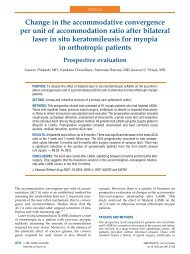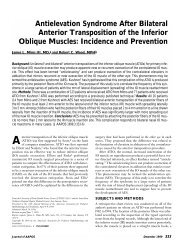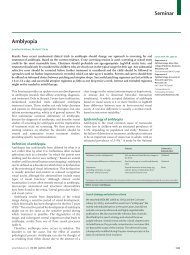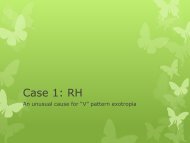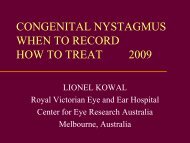What's new AAPOS 2008 - The Private Eye Clinic
What's new AAPOS 2008 - The Private Eye Clinic
What's new AAPOS 2008 - The Private Eye Clinic
Create successful ePaper yourself
Turn your PDF publications into a flip-book with our unique Google optimized e-Paper software.
Secondary acute myeloid leukemia after etoposide therapy for retinoblastoma.<br />
Weintraub M, Revel-Vilk S, Charit M, et al<br />
Pediatr Hematol Oncol 2007, Vol 29; 9<br />
This is a case report of a child diagnosed with RB at age 2 months with bilateral RB.<br />
<strong>The</strong> child was found to have partial mosaicism for R35X mutation of the RB gene. She<br />
was treated with chemotherapy (vincristine, carboplatinum, and etoposide); six cycles.<br />
She required 4 cryotherapy sessions for persistent lesions, with a complete response.<br />
At the age of 2 years; 22 months after the diagnosis of RB and 18 months after the last<br />
dose of etoposide, the patient was diagnosed with secondary M4 acute myeloid<br />
leukemia.<br />
Secondary AML may occur after therapy with topoisomerase II inhibitors<br />
(anthracyclines, epipodophyllotoxins) or with alkylating agents (cyclophosphamide,<br />
procarbazine). It occurs in both adults and children and is usually associated with a<br />
relatively short latency period and with cytogenetic aberrations in chromosome 11Q23,<br />
involving the mixed lineage leukemia (MLL) gene. <strong>The</strong> most common aberration seen<br />
is t(9;11). <strong>The</strong> presumed mechanism of topoisomerase-associated t AML is formation<br />
of translocations as a result of defective breakage repair after cleavage of DNA by<br />
topoisomerase II.<br />
From the archives of the AFIP. Pediatric orbit tumors and tumor-like lesions:<br />
Neuroepithelial lesions of the ocular globe and optic nerve.<br />
Chang EM, Specht CS, Schroeder JW.<br />
Radiographics 2007 Jul-Aug; 27(4):1159-86.<br />
This a superb review article. <strong>The</strong>y describe the imaging features and pathologic bases<br />
of ocular and optic nerve neuroepithelial neoplasms in children (RB,<br />
pseudoretinoblastoma: PHPV, Coats disease, Toxocara; Medulloepithelioma, and<br />
Optic Nerve Glioma_ <strong>The</strong>y discuss the differentiating features amongst these masses<br />
and discuss the differential diagnoses. <strong>The</strong>y even discuss the treatment and prognosis<br />
for each.<br />
Trilateral Retinoblastoma.<br />
Antoneli CBG, Ribeiro K, Sakamoto LH, Chojniak MM, Novaes PE, Arias VE.<br />
Pediatr Blood Cancer 2006 Mar 29; [Epub ahead of print]<br />
This is a good review article on Tuberous Sclerosis (TSC), an autosomal dominant<br />
multisystem disorder. It occurs by spontaneous mutation in approximately 70% of<br />
affected. Mutations in the TSC1 gene, on chromosome 9q34, and TSC3 gene, on<br />
chromosome 16913.3, result in a similar phenotypic presentation. TSC1 is more<br />
common in familial cases and results in less severe disease. <strong>The</strong> pathogenesis of TSC<br />
lies in the expression and function of the gene products, tuberin in TSC2 and hamartin<br />
in TSC1, in tissue. <strong>The</strong> interaction between these two proteins as been shown to be<br />
71



